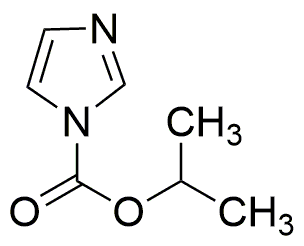Isopropyl 1H-imidazole-1-carboxylate is widely utilized in research focused on:
- Pharmaceutical Development: This compound serves as a key intermediate in the synthesis of various pharmaceuticals, particularly in the development of anti-inflammatory and anti-cancer agents.
- Agricultural Chemicals: It is used in formulating agrochemicals, enhancing the efficacy of pesticides and herbicides, which helps in improving crop yield and protection.
- Biochemical Research: Researchers employ this compound in studying enzyme activities and metabolic pathways, providing insights into biological processes and potential therapeutic targets.
- Material Science: It finds applications in the development of advanced materials, including polymers and coatings, due to its unique chemical properties that enhance durability and performance.
- Diagnostic Reagents: This chemical is also utilized in creating diagnostic reagents for various assays, aiding in the detection and quantification of biomolecules in clinical settings.
General Information
Properties
Safety and Regulations
Applications
Isopropyl 1H-imidazole-1-carboxylate is widely utilized in research focused on:
- Pharmaceutical Development: This compound serves as a key intermediate in the synthesis of various pharmaceuticals, particularly in the development of anti-inflammatory and anti-cancer agents.
- Agricultural Chemicals: It is used in formulating agrochemicals, enhancing the efficacy of pesticides and herbicides, which helps in improving crop yield and protection.
- Biochemical Research: Researchers employ this compound in studying enzyme activities and metabolic pathways, providing insights into biological processes and potential therapeutic targets.
- Material Science: It finds applications in the development of advanced materials, including polymers and coatings, due to its unique chemical properties that enhance durability and performance.
- Diagnostic Reagents: This chemical is also utilized in creating diagnostic reagents for various assays, aiding in the detection and quantification of biomolecules in clinical settings.
Documents
Safety Data Sheets (SDS)
The SDS provides comprehensive safety information on handling, storage, and disposal of the product.
Product Specification (PS)
The PS provides a comprehensive breakdown of the product’s properties, including chemical composition, physical state, purity, and storage requirements. It also details acceptable quality ranges and the product's intended applications.
Certificates of Analysis (COA)
Search for Certificates of Analysis (COA) by entering the products Lot Number. Lot and Batch Numbers can be found on a product’s label following the words ‘Lot’ or ‘Batch’.
Número de catálogo
Número de lote/lote
Certificates Of Origin (COO)
This COO confirms the country where the product was manufactured, and also details the materials and components used in it and whether it is derived from natural, synthetic, or other specific sources. This certificate may be required for customs, trade, and regulatory compliance.
Número de catálogo
Número de lote/lote
Safety Data Sheets (SDS)
The SDS provides comprehensive safety information on handling, storage, and disposal of the product.
DownloadProduct Specification (PS)
The PS provides a comprehensive breakdown of the product’s properties, including chemical composition, physical state, purity, and storage requirements. It also details acceptable quality ranges and the product's intended applications.
DownloadCertificates of Analysis (COA)
Search for Certificates of Analysis (COA) by entering the products Lot Number. Lot and Batch Numbers can be found on a product’s label following the words ‘Lot’ or ‘Batch’.
Número de catálogo
Número de lote/lote
Certificates Of Origin (COO)
This COO confirms the country where the product was manufactured, and also details the materials and components used in it and whether it is derived from natural, synthetic, or other specific sources. This certificate may be required for customs, trade, and regulatory compliance.


